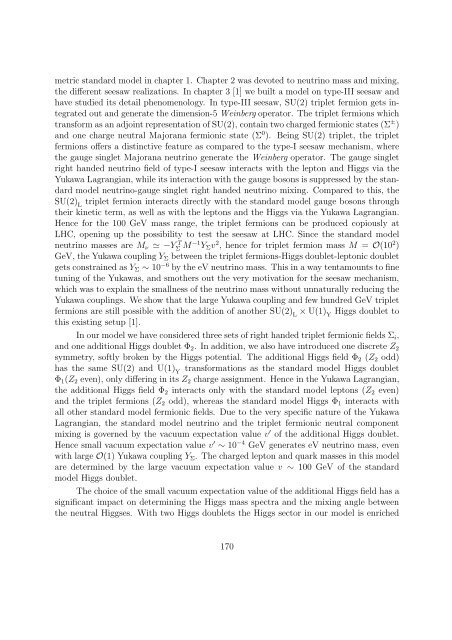PHYS08200604017 Manimala Mitra - Homi Bhabha National Institute
PHYS08200604017 Manimala Mitra - Homi Bhabha National Institute
PHYS08200604017 Manimala Mitra - Homi Bhabha National Institute
You also want an ePaper? Increase the reach of your titles
YUMPU automatically turns print PDFs into web optimized ePapers that Google loves.
metric standard model in chapter 1. Chapter 2 was devoted to neutrino mass and mixing,<br />
the different seesaw realizations. In chapter 3 [1] we built a model on type-III seesaw and<br />
have studied its detail phenomenology. In type-III seesaw, SU(2) triplet fermion gets integrated<br />
out and generate the dimension-5 Weinberg operator. The triplet fermions which<br />
transformasanadjointrepresentationofSU(2), containtwochargedfermionicstates(Σ ± )<br />
and one charge neutral Majorana fermionic state (Σ 0 ). Being SU(2) triplet, the triplet<br />
fermions offers a distinctive feature as compared to the type-I seesaw mechanism, where<br />
the gauge singlet Majorana neutrino generate the Weinberg operator. The gauge singlet<br />
right handed neutrino field of type-I seesaw interacts with the lepton and Higgs via the<br />
Yukawa Lagrangian, while its interaction with the gauge bosons is suppressed by the standard<br />
model neutrino-gauge singlet right handed neutrino mixing. Compared to this, the<br />
SU(2) L<br />
triplet fermion interacts directly with the standard model gauge bosons through<br />
their kinetic term, as well as with the leptons and the Higgs via the Yukawa Lagrangian.<br />
Hence for the 100 GeV mass range, the triplet fermions can be produced copiously at<br />
LHC, opening up the possibility to test the seesaw at LHC. Since the standard model<br />
neutrino masses are M ν ≃ −Y T Σ M−1 Y Σ v 2 , hence for triplet fermion mass M = O(10 2 )<br />
GeV, theYukawa couplingY Σ between thetriplet fermions-Higgsdoublet-leptonic doublet<br />
gets constrained as Y Σ ∼ 10 −6 by the eV neutrino mass. This inaway tentamounts to fine<br />
tuning of the Yukawas, and smothers out the very motivation for the seesaw mechanism,<br />
which was to explain the smallness of the neutrino mass without unnaturally reducing the<br />
Yukawa couplings. We show that the large Yukawa coupling and few hundred GeV triplet<br />
fermions are still possible with the addition of another SU(2) L<br />
×U(1) Y<br />
Higgs doublet to<br />
this existing setup [1].<br />
Inourmodel wehave considered threesets ofright handedtriplet fermionicfields Σ i ,<br />
and one additional Higgs doublet Φ 2 . In addition, we also have introduced one discrete Z 2<br />
symmetry, softly broken by the Higgs potential. The additional Higgs field Φ 2 (Z 2 odd)<br />
has the same SU(2) and U(1) Y<br />
transformations as the standard model Higgs doublet<br />
Φ 1 (Z 2 even), only differing in its Z 2 charge assignment. Hence in the Yukawa Lagrangian,<br />
the additional Higgs field Φ 2 interacts only with the standard model leptons (Z 2 even)<br />
and the triplet fermions (Z 2 odd), whereas the standard model Higgs Φ 1 interacts with<br />
all other standard model fermionic fields. Due to the very specific nature of the Yukawa<br />
Lagrangian, the standard model neutrino and the triplet fermionic neutral component<br />
mixing is governed by the vacuum expectation value v ′ of the additional Higgs doublet.<br />
Hence small vacuum expectation value v ′ ∼ 10 −4 GeV generates eV neutrino mass, even<br />
with large O(1) Yukawa coupling Y Σ . The charged lepton and quark masses in this model<br />
are determined by the large vacuum expectation value v ∼ 100 GeV of the standard<br />
model Higgs doublet.<br />
The choice of the small vacuum expectation value of the additional Higgs field has a<br />
significant impact on determining the Higgs mass spectra and the mixing angle between<br />
the neutral Higgses. With two Higgs doublets the Higgs sector in our model is enriched<br />
170
















